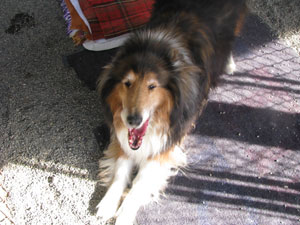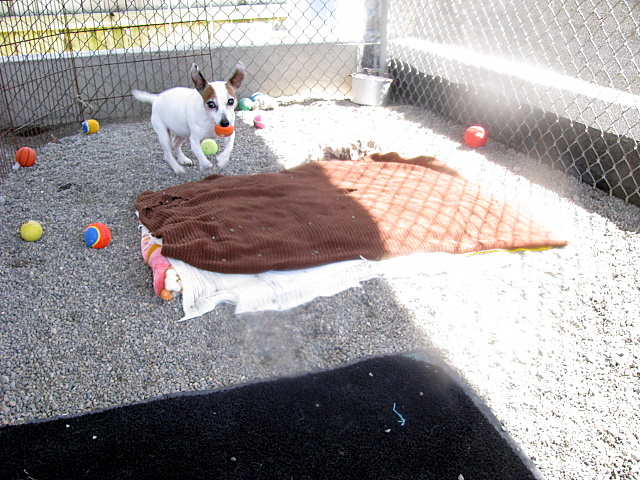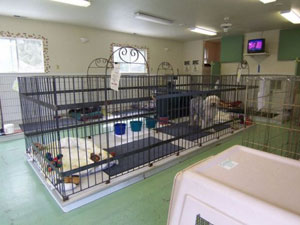GERIATRICS:Our Specialty

Contents
- Geriatrics: What is it?
- Geriatrics:Who is it for?
- Diet:Nutrition advice
What is our geriatric facility?
Originally, it was intended for older dogs with age related health problems. Liz converted a rambler-style house on the kennel property into a dog-proof dormitory. The living room and bedroom were divided into pens padded with quilts and blankets. It was a much softer, quieter atmosphere than the actual kennel.
It was an easy walk for the dogs to get to their outside yards for the day. This building was also where the dogs meals were prepared and laundry was done. The dogs always had plenty of people contact throughout the day. The quiet atmosphere coupled with Liz's extensive knowledge of animal medicine, was the ideal solution for dogs who needed post operative care.
Vets began referring customers with dogs that didn't need monitoring at the vet's office, but still needed to be kept quiet and inactive. Then, during kennel tours, customers began asking questions about the geriatric ward. They asked if their little lap dogs couldn't stay there also, even though they weren't sick. They were concerned that their little 10 pound dog wouldn't fare well in the kennel environment.
The noise and energy of the larger dogs in the kennel can be quite intimidating. The geriatric ward soon became quite popular, and the waiting list for reservations kept getting longer. Last year we added an addition, and we more than doubled the size. We added things like cable tv, a vcr for home movies that families bring of themselves, air conditioning, night lights, and piped-in music.
Who is it for ?

Although we still call it our geriatric ward, it is really much more than that, it is for:
- older dogs
- dogs with chronic ailments
- dogs needing daily medications
- post-operative care
- pampered puppies
- lap dogs
- scared dogs away from home for the first time
It provides the least amount of trauma and transition shock from your home to a kennel environment. The dogs are given throw rugs, comforters, blankets and toys.
Each dog has their own outdoor exercise yard, and they get to play outside all day, temperature permitting. Their food is microwaved, and for the chewing impaired, we feed baby food and cottage cheese. We can administer medicines including insulin shots, as long as the dosage is fixed.
You are welcome to bring blankets and toys from home, if you think that will make your dog feel more comfortable. And to back everything up, we have 4 generators for emergency electrical power, 300 gallons of stored water, and enough dog food on hand to last four weeks.
Pet Nutritional Advice

THOUGHTS ON NUTRITION: During the first year of a dog's development, proper nutrition is essential. Nutrition has a huge impact on the development of strong bones, strong teeth a shiny coat and whether the dog reaches its potential size for the breed.
Poor nutrition can cause stunted growth, joint problems and a multitude of other problems. Even the best commercial dog foods can loose vitamin potency due to age and storage conditions.
Dog owners might consider supplementing their pet's diet in order to assure the proper diet requirements are satisfied. It is generally agreed that some defects are caused by heredity, but diet plays an equal role.
Vegetables, Vitamin C and Calcium are examples of dietary oversights. Some dog food manufacturers are starting to make up for these shortages and now include vegetables in their products. If you are unsure, there are simple ways to start supplementing your dog's diet today.
The high costs associated with many commercial additives can be offset or avoided altogether since essential ingredients are readily available in our homes. When preparing your own dinner, set aside a small portion of vegetables to mix with your dog's dinner. Chop them into small pieces (if veggies are frozen, simply let thaw or warm slightly). Vitamin C in capsule form such as Ester-C can be opened and the powder sprinkled on the food.
Calcium can be added by adding plain yogurt or lowfat cottage cheese-simply mix with the dry food. Yogurt is an excellent source of calcium and provides amino acids necessary for digestion. Try feeding 1/2 cup plain yogurt once a day. Calcium tablets are also available from your pet supplier. Things to avoid:
- Whole milk, including 1 or 2%. It will cause diarrhea.
- Chocolate and other sweets.
- Fried food, pork including bacon or bacon grease.
- Chicken bones and other bones other than large marrow bones.
- Toxic house plants such as pothos and poinsettias.
If all of this seems troublesome, it is far less trouble than the associated vet bills that can be a result of misfeeding.
